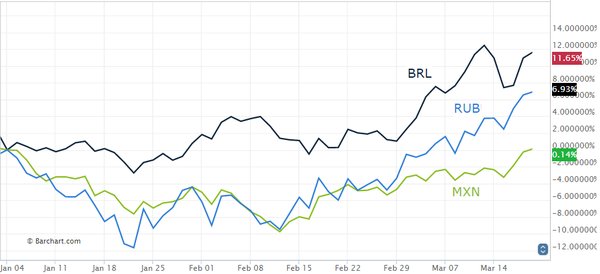Greetings,
We start with Russia where the central bank did not cut rates in spite of falling inflation. Given the persistent economic weakness, the rationale for such policy is unclear other than an attempt to strengthen the ruble further. This is certainly a hawkish stance by the Bank of Russia.

Source: Natixis
Driven by firmer energy prices, a broadly weaker US dollar, and the central bank’s hawkish stance, the Russian ruble indeed continues to strengthen (chart shows how many rubles one dollar buys).

Source: barchart
On a year-to-date basis, the ruble has diverged from the Mexican peso and is now up nearly 7%. Here is the relative performance of the ruble (RUB), the Brazilian real (BRL), and the Mexican peso (MXN) vs. USD.

Source: @SoberLook
We now see speculative accounts jumping into long Russian ruble positions, betting on further appreciation.

Turning to other emerging markets, here are a few updates.
1. Colombia’s central bank hiked the benchmark rate 25 bp to stem inflation and strengthen the currency.


2. Argentina’s current account deficit hits a record. It’s a tough road ahead for Mauricio Macri.

3. Egypt’s unofficial inflation spikes and is expected to worsen as Cairo devalued the currency last week. That’s why the central bank hiked rates more than expected.

Source: ?@jsblokland, @steve_hanke
4. When it comes to tracking demand for oil, most analysts focus on China. However, India’s demand for fuel is on the rise and is expected to rival that of China.

Source: Macquarie
5. Speaking of crude oil, Iraq’s production hit a new high recently.

Source: Credit Suisse, h/t Josh
6. Singapore’s labor market stalls on China’s slowdown.

Source: BAML, h/t Josh
Here are some updates on China.
1. The country’s business sentiment remains soft.

Source: Goldman Sachs, h/t Josh












Leave A Comment